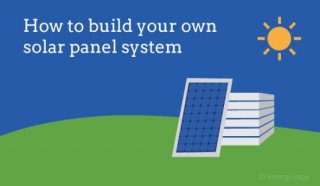DIY Solar Setup
 When you install solar panels, your home produces its own clean, zero-emissions electricity. If you’re DIY-minded, you can build your own solar power system. In some cases, you can even build your own solar panels, although the amount that you can effectively DIY home solar depends on how much you want to power.
When you install solar panels, your home produces its own clean, zero-emissions electricity. If you’re DIY-minded, you can build your own solar power system. In some cases, you can even build your own solar panels, although the amount that you can effectively DIY home solar depends on how much you want to power.
Learn How to Make Your Own Solar Panels
Making your own solar panel is a time-consuming process and requires some electrical skills. However, it can also be very rewarding – learning to build your own PV panel is a great way to understand how solar electricity is generated.
Before you can build your own solar panels, you first need to understand how solar cells generate electricity. The vast majority of solar panels in use today are made of crystalline silicon wafers, which typically measure six inches square. When the sun shines on those wafers, the electrons in them start to move. This flow of electrons is an electrical current.
A single full-sized solar panel, like the kind used in rooftop solar power systems, will have 60 silicon wafers. You can also make smaller panels if your electricity needs are low. Once you’ve bought individual solar cells (they can be purchased online), the basic process for building your own solar panel goes like this:
Prepare the backing for your panel. Many DIY solar panel builders use a wooden board as the base for their solar cells. You’ll need to drill holes in the board so that the wires for each cell can pass through.
Wire your solar cells together. This requires some experience with electrical work. Use a soldering iron to attach wire to the solar cells and then link each of the cells together.
Attach cells to your backing. If possible, affix each solar cell to the backing individually. This makes it easier to replace a single cell in the event that becomes damaged or is not operating properly.
At this point you have a functional solar panel that can produce electricity when the sun shines. However, a solar panel by itself is not useful. If you are trying to generate electricity to power devices in your home, you need to pair your panel with an inverter that will turn direct current (DC) power from the sun into the alternating current (AC) power used in most modern electronic devices.
For a standalone off-grid system, you will also need to include a battery pack and charge controller in your DIY solar setup. The battery pack serves to store excess energy, and the charge controller manages the amount of electricity that flows through the battery.









